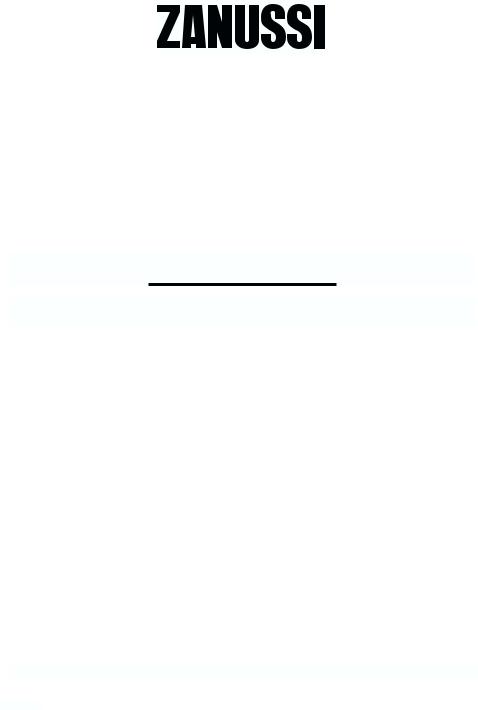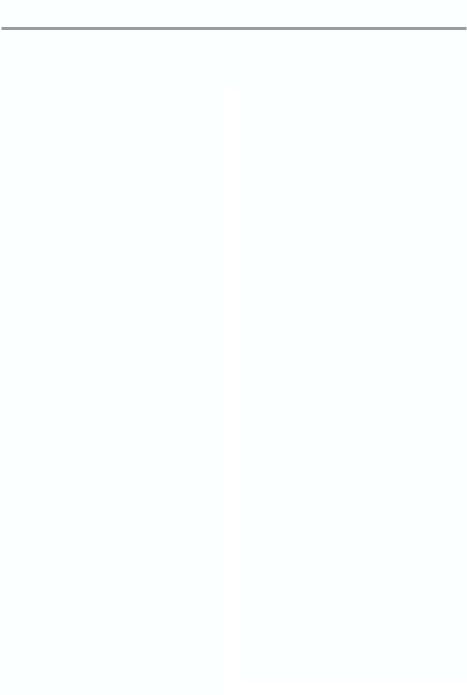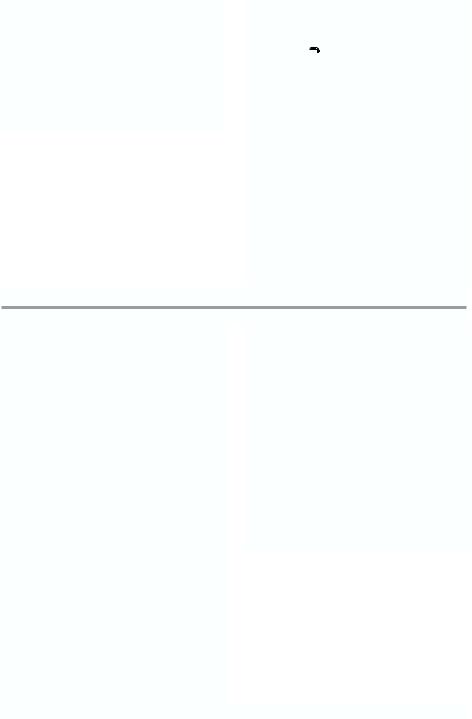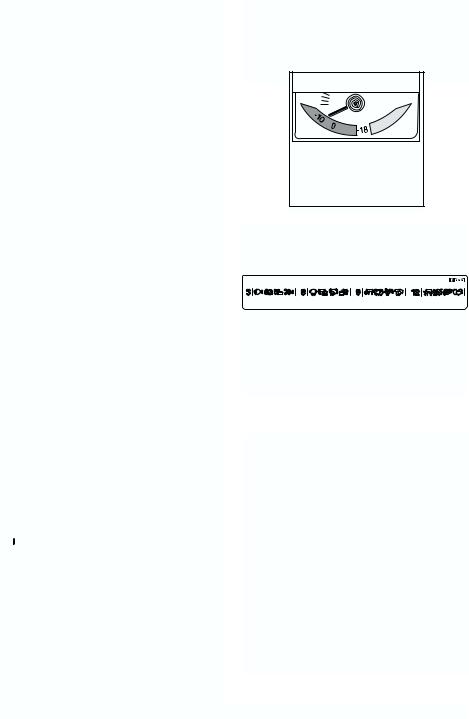Zanussi ZUD 9100 FA User Manual

FREEZER
ZUD 9100 FA
INSTRUCTION BOOKLET
2222740-66

 Important Safety Instructions
Important Safety Instructions
These warnings are provided in the interests of your safety. Ensure that you understand them all before installing or using this appliance. Your safety is of paramount importance. If you are unsure about any of the meanings of these warnings contact the Customer Care Department.
Prior to Installation
•Check the appliance for transport damage. Under no circumstance should a damaged appliance be installed. In the event of damage please contact your retailer.
Installation
•This appliance is heavy. Care should be taken when moving it.
•It is dangerous to alter the specifications or attempt to modify this product in any way.
•Ensure that the appliance does not stand on the electrical supply cable. Important: if the supply cable is damaged, it must be replaced by authorized service or qualified personnel using a special cable of the same type.
•Any electrical work required to install this appliance should be carried out by a qualified electrician or competent person.
•Parts which heat up should not be exposed. Whenever possible, the back of the appliance should be close to a wall, but leaving the required distance for ventilation, as stated in the installation instructions.
•The appliance should be left for 2 hours after installation before it is turned on, in order to allow the refrigerant to settle.
Refrigerant
•The refrigerant isobutane (R600a) is contained within the refrigerant circuit of the appliance, a natural gas with a high level of environmental compatibility, which is nevertheless flammable.
•During transportation and installation of the appliance, be certain that none of the components of the refrigerant circuit become damaged.
•If the refrigerant circuit should become damaged:
-avoid open flames and sources of ignition.
-thoroughly ventilate the room in which the appliance is situated.
Child Safety
•Do not allow children to tamper with the controls or play with the product.
•There is a risk of suffocation! Keep packaging material away from children!
General Safety
•This appliance contains hydrocarbons in its cooling unit; maintenance and recharging must therefore only be carried out by authorised technicians.
•Take utmost care when handling your appliance so as not to cause any damages to the cooling unit with consequent possible fluid leakages.
•The appliance must not be located close to radiators or boilers.
•Avoid prolonged exposure of the appliance to direct sunlight.
•Do not use other electrical appliances (such as ice cream makers) inside of refrigerating appliances.
During Use
•This appliance is designed for domestic use only, specifically for the storage of edible foodstuffs. It is not intended for commercial or industrial use.
•Containers with flammable gases or liquids can leak at low temperatures. Do not store any containers with flammable materials, such as spray cans, fire extinguisher refill cartridges etc. in the freezer.
•Frozen food should not be refrozen once it has thawed out.
•Do not place carbonated or fizzy drinks in the freezer compartment.
•Ice lollies can cause ‘frost/freezer burns’ if consumed straight from the freezer.
•Do not remove items from the freezer compartment if your hands are damp/wet, as this could cause skin abrasions or frost/freezer burns.
•Bottles and cans must not be placed in the freezer as they can burst when the contents freeze.
•Manufacturers’ recommended storage times should be adhered to. Refer to relevant instructions.
Maintenance and Cleaning
•Before cleaning, always switch off the appliance and disconnect from the electrical supply.
•When unplugging always pull the plug from the mains socket, do not pull on the cable.
2 |
Printed on paper manufactured with environmentally sound processes |

Servicing
•This product should be serviced by an authorised engineer and only genuine spare parts should be used.
•Under no circumstances should you attempt to repair the appliance yourself. Repairs carried out by inexperienced persons may cause injury or serious malfunctioning. Contact your local Service Force Centre.
At the end of the Appliance Life
•When disposing of your appliance use an authorised disposal site.
The symbol  on the product or on its packaging indicates that this product may not be treated as household waste. Instead it shall be handed over to the applicable collection point for the recycling of electrical and electronic equipment. By ensuring this product is disposed of correctly, you will help prevent potential negative consequences for the environment and human health, which could otherwise be caused by inappropriate waste handling of this product. For more detailed information about recycling of this product, please contact your local city office, your household waste disposal service or the shop where you purchased the product.
on the product or on its packaging indicates that this product may not be treated as household waste. Instead it shall be handed over to the applicable collection point for the recycling of electrical and electronic equipment. By ensuring this product is disposed of correctly, you will help prevent potential negative consequences for the environment and human health, which could otherwise be caused by inappropriate waste handling of this product. For more detailed information about recycling of this product, please contact your local city office, your household waste disposal service or the shop where you purchased the product.
•Remove the plug and ensure that any locks or catches are removed, to prevent young children being trapped inside.
Contents
Instructions for the User
Important Safety Instructions . . . . . . . . . . . . . . . .2
Operation . . . . . . . . . . . . . . . . . . . . . . . . . . . . . . . . .4
Before use . . . . . . . . . . . . . . . . . . . . . . . . . . . . . . .4 Freezer controls . . . . . . . . . . . . . . . . . . . . . . . . . . .4 Starting your appliance . . . . . . . . . . . . . . . . . . . . . .4 Temperature control . . . . . . . . . . . . . . . . . . . . . . . .4 Warning light (red) . . . . . . . . . . . . . . . . . . . . . . . . .4 Temperature acoustic alarm . . . . . . . . . . . . . . . . . .4 Open door acoustic alarm . . . . . . . . . . . . . . . . . . .4 Freezing fresh food . . . . . . . . . . . . . . . . . . . . . . . .5 Frozen food storage . . . . . . . . . . . . . . . . . . . . . . . .5 Internal thermometer . . . . . . . . . . . . . . . . . . . . . . .5 Freezing calendar . . . . . . . . . . . . . . . . . . . . . . . . .5 Thawing . . . . . . . . . . . . . . . . . . . . . . . . . . . . . . . . .5 Making ice cubes . . . . . . . . . . . . . . . . . . . . . . . . . .6 Normal operating sounds . . . . . . . . . . . . . . . . . . . .6
Health and Safety Guidelines . . . . . . . . . . . . . . . .6
Defrosting . . . . . . . . . . . . . . . . . . . . . . . . . . . . . . . .7
Maintenance and Cleaning . . . . . . . . . . . . . . . . . .7
Internal cleaning / Periodic cleaning . . . . . . . . . . .7
Something Not Working? . . . . . . . . . . . . . . . . . . . .8
Service and Spare Parts . . . . . . . . . . . . . . . . . . . . .9
Customer Care Department . . . . . . . . . . . . . . . . . .9
Guarantee Conditions . . . . . . . . . . . . . . . . . . . . .10
Instructions for the Installer
Technical Specifications . . . . . . . . . . . . . . . . . . .11 Installation . . . . . . . . . . . . . . . . . . . . . . . . . . . . . .11
Positioning . . . . . . . . . . . . . . . . . . . . . . . . . . . . . .11
Door reversal . . . . . . . . . . . . . . . . . . . . . . . . . . . .12 Electrical Connection . . . . . . . . . . . . . . . . . . . . .13 Building-in Instructions . . . . . . . . . . . . . . . . . . . .14
Grid preparation . . . . . . . . . . . . . . . . . . . . . . . . . .14 Building in the appliance under a worktop . . . . . .14 Fitting the plinth . . . . . . . . . . . . . . . . . . . . . . . . . .17
3

Operation
Before use
Remove all securing tapes. Wash inside the appliance with lukewarm water and bicarbonate of soda (5 ml to 0.5 litre of water). Do not use soap or detergent as the smell may linger. Dry thoroughly.
Freezer controls
1
6
 2
2
5 |
3 |
|
4 |
||
|
1Pilot light (green)
2Thermostat control knob
3Fast-freezing indicator light (yellow)
4Push button for fast-freezing and for stopping the audible signal (warning light on)
5Warning light (red)
Starting your appliance
Insert the plug into the wall socket.
The appliance can be activated by turning the thermostat knob (2) beyond the «O» position. When the pilot light (1) is illuminated and a sound is on only for 2 sec. this shows that the appliance is on.
Push the button (4), the sound signal alarm will get off and pushing the button a second time the super control light (3) light up. The freezer will start to operate.The freezer is switched off by turning knob
(2) to position «O» and a sound is on only for 2 sec.
Temperature control
The temperature within the freezer is controlled by the thermostat control knob (2) situated at the bottom of the cabinet.
To operate the freezer proceed as follows:
Turn the thermostat control knob beyond the «O» position. When you first start the freezer, we suggest that you turn the thermostat control knob to a medium setting. For easier turning of this control, use a small coin. The internal temperature of the freezer is automatically adjusted by the thermostat to ensure safe food storage. However, if the appliance is working in unfavourable room conditions such as high temperature and frequent door openings, it may be necessary to select a more suitable setting. To obtain a lower temperature, turn the thermostat contol knob towards high numbers; to obtain a higher temperature turn the control knob towards the low numbers.
Warning light (red)
If the temperature warning light (5) blinks, it indicates that the temperature within the freezer has reached a level where the safe food storage is no longer ensured.
When the freezer is first switched on, the warning light will stay on until the temperature has dropped to a safe level for the storage of frozen food.
Temperature acoustic alarm
This appliance incorporates an alarm which gives off an audible signal whenever the warning light comes on. This signal can be temporarily stopped by depressing the push button for fast-freezing (4).
The fast-freezing push button can be released as soon as the warning light is off.
Open door acoustic alarm
This appliance also incorporates an alarm which sounds if the door is left open for more than 60 seconds. The signal will be stopped when the door is closed again.
4

Freezing fresh food
In any 24 hour period you can freeze up to 18 kg of fresh food.
Activate fast freeze by depressing the fast-freeze button (4) 24 hours before you want to freeze your fresh food, the yellow light (3) illuminates. This time can be shortened, depending on the quantity of food to be frozen. After the time has elapsed place the food to be frozen in the two top compartments of the freezer as this is the coldest part; if freezing only a small amount of food, always use the top compartment.
Once the food is completely frozen (which could take up to 24 hours) press the fast freeze switch to deactivate the fast freeze mode; the yellow light (3) goes off.
If the quick-freezing function is not ended manually, the appliance switch off the quick-freezing function after 52 hours. The yellow light goes out.
Distribute the frozen food packages in the other compartments, so that the top compartments can be used for a further freezing operation.
Only freeze top quality, fresh and thoroughly cleaned foodstuffs.
Do not allow fresh food to touch food which is already frozen.
During the freezing process, ensure that the freezer door remains closed.
Frozen food storage
When you first start the freezer or if the freezer has been out of use for some time, we advise you to run your appliance for at least two hours in the «fast freeze» mode before storing frozen food.
To obtain the best performance from this appliance, we strongly recommend that you make sure that the commercially frozen foodstuffs were adequately stored by the retailer and, furthermore, be sure that these frozen foodstuffs are transferred from the foodstore to the consumer in the shortest possible time (a temperature increase of the frozen food could shorten its storage period). It is also advisable not to exceed the storage period indicated by the producer of the food. Finally, do not open the door frequently or leave it open longer than is absolutely necessary.
 Important
Important
Do not put carbonated liquids, (fizzy drinks etc.), in the freezer compartment. Ice lollies, if consumed immediately after removal from the freezer, can possibly result in a low temperature skin burn. Do not remove items from the freezer if your hands are damp/wet, as this could cause skin abrasions or "frost/freezer burns". If there is a power failure during the storage of frozen food, do not open the door during the whole time of the power failure. If the freezer is fully loaded, the frozen food will not be affected if the power cut is of short duration; otherwise, it is recommended to consume the food within a very short time.
Internal thermometer
This indicates the internal temperature of the freezer. It may indicate a temperature above -18°C when large quantities of food are placed inside for freezing or when the door is left open for a long time.
°C |
PR202 |
Freezing calendar
The following symbols show different types of frozen goods.
The numbers indicate storage times in months for the appropriate types of frozen goods. Whether the upper or lower value of the indicated storage time is valid depends on the quality of the foods and pretreating before freezing.
Thawing
Frozen food, prior to being used, can be thawed in the fridge or at room temperature depending on the time available. Small food items may even be cooked from frozen; in this case cooking will take longer. Any frozen food which is allowed to thaw accidentally should either be eaten as soon as possible or thrown away. Alternatively, if the food is uncooked and has not been completely defrosted it can be cooked and then refrozen.
Defrosted cooked food must never be refrozen.
Ice making
Fill each compartment of the ice tray 3/4full with water and place it in the freezer. To release the ice cubes, twist the tray along its length. Never use a sharp instrument to remove ice from the tray.
5

Making ice cubes
The appliance is provided with a plastic ice cube tray. Fill the tray 3/4 full to allow the ice to expand and place it in the freezer. To turn out the ice cubes simply give the tray a slight twist to release the cubes.
Never try to free an ice tray that is frozen to the freezer using a sharp or pointed object.
Normal Operating Sounds
You may hear faint gurgling or bubbling sounds when the refrigerant is pumped through the coils or tubing at the rear, to the fixed freezer shelves.
When the compressor is on, the refrigerant is being pumped round, and you will hear a whirring sound or pulsating noise from the compressor.
A thermostat controls the compressor, and you will hear a faint ‘click’ when the thermostat cuts in and out.
 Health and Safety Guidelines
Health and Safety Guidelines
Because of consumer demand, preservatives have been removed from many pre-prepared foods. This together with the changes in shopping habits to a once-a-week shop, mean that safe handling and storage of food is even more important than ever.
The following tips should help you to ensure that the food in your home is in as perfect condition as possible.
•Keep the freezer door closed as much as possible.
•Do not push food together too much, try to allow air to circulate around each item.
•Cool cooked food as quickly as possible but do NOT place in the freezer until cool. (Leave food in a place as cool as possible in order that it can then be placed in the refrigerator as soon as possible).
•Do not store food uncovered.
•The best way to defrost food is to put it in the refrigerator to thaw slowly.
•Ensure that food placed in the freezer is dated and labelled and used in date order to ensure that food is consumed at its best.
•It is important that food is used before its “best before” date.
•Always wash your hands with soapy water and dry them with a clean towel before handling food.
•Keep work surfaces clean and avoid cross contamination by not using the same work surface or knife, without washing them thoroughly in between.
•The foods to be frozen must be fresh and of the best quality.
•The size of each pack should be small enough to ensure that it is used in one go. Small packs freeze more quickly and uniformly and give better results.
•Frozen food, once thawed, must not be refrozen. Lean food keeps better and longer than fatty food, salt reduces the storage time.
•Wrap the food in polythene or aluminium freezing bags or foil so that they adhere to the food and provide an airtight seal.
•Packaging which is swollen or has traces of refrozen water droplets on the pack could indicate that the product has not been kept at a suitable temperature and that it may have lost its original quality. Partially thawed food must not be refrozen, it must be consumed within 24 hours. Never exceed the storage time indicated.
•Never place hot food, bottles or cans of fizzy drink in the freezer as they may explode. Containers with a lid must not be filled to the brim.
•Do not open the door or place extra fresh food in the freezer next to food which is already frozen as this could cause the temperature of the frozen food to rise and its quality and storage life to reduce.
Important
In the event of a power failure causing the temperature within your freezer to rise, do not refreeze the food without checking its condition. The following guidelines should assist you: Ice-cream: once thawed should be discarded.
Fruits & Vegetables: if soft should be cooked and used up. Breads & Cakes: can be re-frozen without danger. Shellfish: should be refrigerated and used up quickly.
Cooked Dishes: i.e. casseroles should be refrigerated and used up.
Large Pieces of Meat: can be re-frozen providing there are still ice crystals remaining within them. Small Joints: should be cooked and can then be re-frozen as cooked dishes.
Chicken: should also be cooked and re-frozen as a cooked dish.
6
